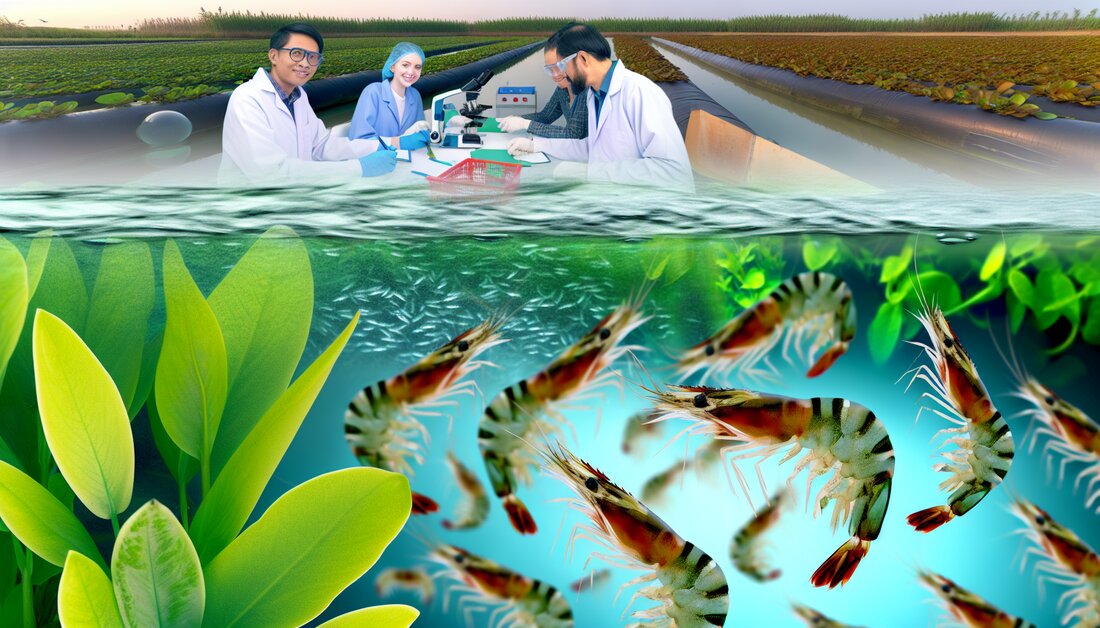Phytochemical power against AHPND: New hope for shrimp farming
New research reveals that myricetin, taxifolin, EGCG and strychnine are effective phytochemicals against PirA/B toxins from Vibrio parahaemolyticus in shrimp farming! 🌿🦐 #Science #Aquaculture

Phytochemical power against AHPND: New hope for shrimp farming
Shrimp production in Southeast Asia is currently threatened by a new disease: acute hepato-pancreatic necrosis disease (AHPND). This bacterial disease particularly affects the Pacific white shrimp, Litopenaeus vannamei, an economically very important species. A dangerous pathogen, Vibrio parahaemolyticus, has been identified as the central pathogen. This pathogen can carry a gene that codes for toxic proteins that destroy cells by triggering their death.
Current research has investigated ways to render these toxic proteins harmless. Four plant substances were discovered to be promising: myricetin, ( +)-taxifolin, (-)-epigallocatechin-3-gallate (EGCG) and strychnine. In particular, ( +)-taxifolin and EGCG showed good effectiveness in laboratory tests by impairing the stability of the pathogen's protein structures and thus limiting their destructive effects.
The researchers also tested the antibacterial effectiveness of these substances against the pathogen. EGCG proved to be particularly effective at a concentration of 1 mg/ml and was able to eliminate almost all pathogens within 24 hours.
Possible future applications could include using these substances as additives to shrimp feeds to prevent or control outbreaks of AHPND. This could significantly reduce losses in shrimp production and set new standards in disease management in aquaculture.
Basic terms and concepts
- Aquakultur: Die Zucht und Haltung von Wassertieren oder Pflanzen in kontrollierten Umgebungen für kommerzielle Zwecke.
- Pathogen: Ein Mikroorganismus, der Krankheiten verursacht.
- Virulenzplasmid: Ein DNA-Fragment in Bakterien, das Gene trägt, die die Krankheit verursachen können.
- Phytocompounds: Chemische Verbindungen, die in Pflanzen vorkommen, oft mit gesundheitlichen Vorteilen.
- In silico: Computergestützte Analyse oder Simulationen von biologischen Prozessen.
- Docking Score: Ein Maß für die Bindungsstärke und -affinität eines Moleküls an ein Zielprotein in der Biochemie.
- Molekulardynamik: Eine Technik, die die physikalischen Bewegungen von Atomen und Molekülen simuliert.
- RMSD (Root Mean Square Deviation): Ein statistisches Maß für die Unterschiede zwischen beobachteten und berechneten Positionen von Molekülen.
- MIC (Minimale Hemmkonzentration): Die niedrigste Konzentration eines antimikrobiellen Mittels, die das Wachstum eines Mikroorganismus verhindert.
- MBC (Minimale bakterizide Konzentration): Die niedrigste Konzentration eines Mittels, das 99,9 % der Bakterienpopulation abtötet.
Abbreviations
- AHPND: Acute Hepatopancreatic Necrosis Disease
- Myr: Myricetin
- TF: ( +)-Taxifolin
- EGCG: (-)-Epigallocatechin-3-gallate
- STN: Strychnin
- RMSD: Root Mean Square Deviation
- MIC: Minimale Hemmkonzentration
- MBC: Minimale bakterizide Konzentration
Effective phytocompounds against Vibrio parahaemolyticus in shrimp farming
In Southeast Asian shrimp farming, the disease “Acute Hepatopancreatic Necrosis Disease” (AHPND) poses a significant threat. The main cause is the bacteriumVibrio parahaemolyticus, is particularly devastating for the highly sought-after Pacific white shrimp (Litopenaeus vannamei). This research identifies the mechanisms and potential biochemical inhibitors against the pathogenicity ofV. parahaemolyticus.
Pathogenetic mechanism
The pathogenicity pathway ofV. parahaemolyticusis based on a virulence plasmid that encodes binary protein toxins (PirA/B). These toxins are responsible for the destruction of cells and can conjugate others via a post-segregational killing systemVibriospecies are transmitted.
In Silico Analysis and Molecular Dynamics Studies
For the identification of effective inhibitors, four phytocompounds—myricetin (Myr), (+)-taxifolin (TF), (-)-epigallocatechin gallate (EGCG), and strychnine (STN)—were selected using in silico analyzes based on docking scores and affinity. Analysis using Discovery Studio software identified critical amino acid interactions necessary for binding. Molecular dynamic simulations showed that (+)-taxifolin and (-)-epigallocatechin gallate in particular score with lower root mean square deviation (RMSD) values and improved stability against the protein toxins.
| Phytocompound | MBC (mg/mL) | RMSD |
|---|---|---|
| EGCG | 1 | Low |
| TF | 1.25 | Low |
Antibacterial effectiveness
The antibacterial effectiveness of the selected phytocompounds was determined by determining the minimum inhibitory concentration (MIC) and the minimum bactericidal concentration (MBC) against pathogenic strains ofV. parahaemolyticustested. The best MBC results were recorded at 1 mg/mL for EGCG and 1.25 mg/mL for TF. After 24 hours of incubation, a complete reduction in viable cell numbers was observed at these concentrations.
Conclusion
This study provides valuable insights into the use of phytocompounds as potentially efficient inhibitors againstVibrio parahaemolyticus, particularly with regard to their application in aquaculture to combat AHPND. Further investigations could lead to the development of new phytocompound-based treatment strategies.
For more information about the research, see the original study at: https://pubmed.ncbi.nlm.nih.gov/36988845.

 Suche
Suche
 Mein Konto
Mein Konto
